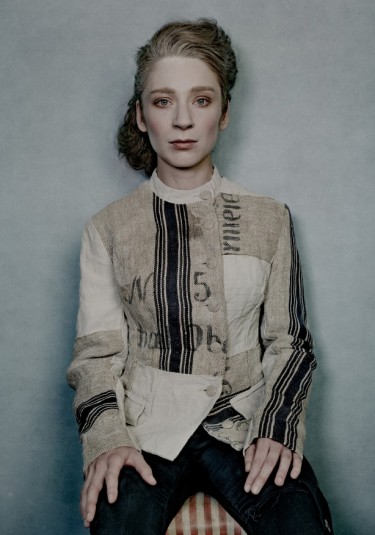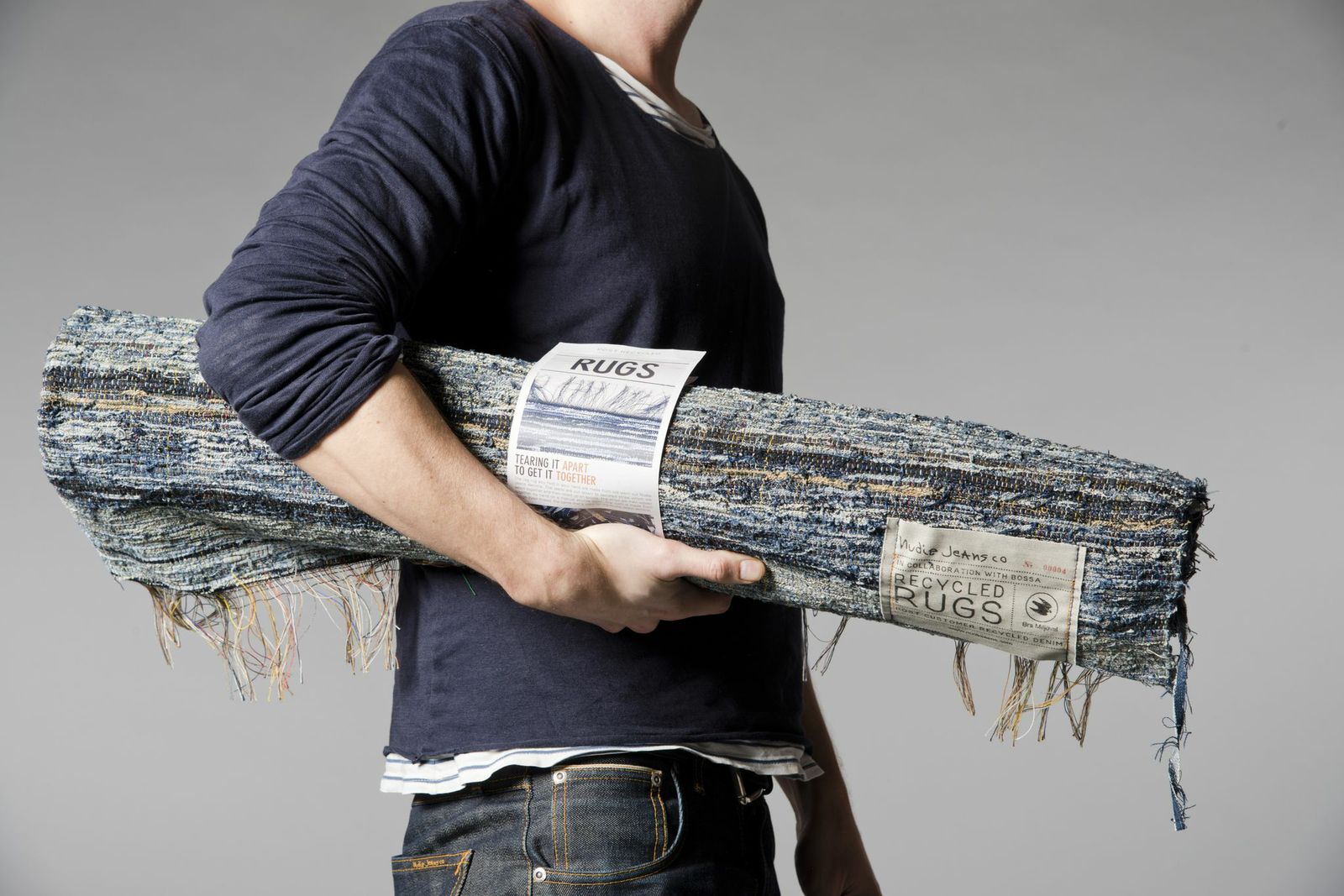
Commentary & Critique - One Man's Trash is Another Man's Treasure
This is the second of a three part series on Design for Recycling, this one focusing on Pre Consumer waste written for the Textile Toolbox, TED's web platform for MISTRA in Sweden.
Reuse of post consumer waste is probably the best-known type of upcycling when it comes to garments and materials, yet it is simultaneously one of the most challenging, when it comes to taking it to scale. There are obvious challenges when working with post consumer garments, each one different in terms of style, size, color, and fabric, requiring individual creative responses to individual creative challenges. The requirement of unique innovative material responses lends itself to artistic solutions, so it is no surprise that the area of upcycling used garments, is dominated by small, independent designers.
A great number of independent designers work highly effectively with post consumer waste to produce quirky, cool and avant-garde designs, along with some larger brands that have undertaken small upcycled capsule collections. The Recycle Denim Maniacs project was a creative undertaking by Swedish brand Nudie Jeans to reimagine old denim jeans into avant-garde and whimsical designs, as interpreted by a group of young designers. Junky Styling in the UK is one of the better known labels upcycling used garments, having garnered the admiration of the likes of Livia Firth, who has worn their designs on the red carpet. Specializing in upcycling men’s suits into highly innovative and original women’s wear, Junky have found a creative solution to the problem of scaling production. The narrow focus of their source material allows them to reproduce the same style multiple times, all be it with different fabrics and colors. Austrian brand MILCH similarly uses men’s suits, but also produce a narrow range of non-seasonal designs to allow for greater production capability, permitting them to wholesale across the country, instead of simply producing individual one offs.
An alternative solution to the problem of non-standardized materials, is to find a means to standardize them. Much as Piece x Piece and R.ds recut pre-consumer waste to a standardized shape and size, Reet Aus cuts post consumer waste into small regular shapes before reconfiguring them into a new patchwork textile base. Welsh brand Raggedy also reconstructs garment waste into a new textile, by sewing destroyed scraps of worn out clothing into a crazy patchwork of new materials. It takes a certain artisanship to coordinate the multiple fabrications, and make a whole out of an uncoordinated mess. Never the less, the technique favored by Raggedy, a sort of crazy squiggle patchwork stitch that binds all the pieces together, does allow for the production of a new base fabric, with which to reimagine new designs. Others have taken this idea a step further, such as Viennese label km/a, who radically narrows their source material and color story to eliminate the artifice required in matching a jumble of mismatched fabrics. Their jersey scrap jacket is produced from tiny shreds of simple cotton T-shirt jersey, previously sorted into monochromatic color stories. Similarly Steinwidder, previously referenced in the pre consumer post, also work with post consumer sock waste, utilizing the same process of narrowing source material and presorting by color, to produce a new base fabric.
 One of the natural assumptions of reimagining used and worn garments, is that that the outcome is new, reinvented, redesigned garments, but that doesn’t need to be the case. Products other than garments may actually be an easier proposition, all be it one outside of the core knowledge of the producer. An example of this is Nudie Jeans Recycled Denim Rug, which Nudie produces entirely from donated worn out denim Jeans. The old jeans are individually cut into strips, sewn together and hand woven using a vintage manual shuttle loom, in the tradition of an arts and crafts rag rug. One of “the barriers to upcycling used clothing”, according to Nudie Jeans CSR Manager, Sandya Lang, is “to have enough quantity of old jeans”. Designer Reet Aus also cites “the challenges of collecting materials, deconstructing garments, washing, redesigning and sewing, (all of) which can be very expensive and time consuming.” Requiring the redefinition of goals, “shifting from ROI to the triple bottom line of people planet profit, or a balance of doing right with making profits which, can be done by a large company.”
One of the natural assumptions of reimagining used and worn garments, is that that the outcome is new, reinvented, redesigned garments, but that doesn’t need to be the case. Products other than garments may actually be an easier proposition, all be it one outside of the core knowledge of the producer. An example of this is Nudie Jeans Recycled Denim Rug, which Nudie produces entirely from donated worn out denim Jeans. The old jeans are individually cut into strips, sewn together and hand woven using a vintage manual shuttle loom, in the tradition of an arts and crafts rag rug. One of “the barriers to upcycling used clothing”, according to Nudie Jeans CSR Manager, Sandya Lang, is “to have enough quantity of old jeans”. Designer Reet Aus also cites “the challenges of collecting materials, deconstructing garments, washing, redesigning and sewing, (all of) which can be very expensive and time consuming.” Requiring the redefinition of goals, “shifting from ROI to the triple bottom line of people planet profit, or a balance of doing right with making profits which, can be done by a large company.”
There are of course other sources of less obvious post consumer waste, not that of garments, but other materials; sailing boat sails, army tents, hot air balloons, post office sacks, farmers flour sacks and domestic textiles like curtains, napkins, tablecloths and mattress ticking. There are several designers working highly successfully with the reutilization of these materials. Christopher Raeburn, the winner of London Fashion Week’s New Gen award, first rose to fame through his reuse of military waste, and continues to do so for such high profile collaborations as with Swiss Army Knife. Raeburn builds close relationships with the likes of Virgin Airways and British Rail, to reuse their decommissioned hot air balloons and uniforms, much as Orsola de Castro builds relationships with factories to source her pre consumer materials for From Somewhere. MAYER Peace collection in Berlin, produce an edgy fashion forward collection from vintage farmers flour sacks; with the graphics, farmer names and holes adding as much value to the finished piece as the workmanship involved in producing the new designs.
The stories embedded in post consumer waste, the honoring of the past, and the history and heritage of textiles is where the true value lies in working with used textiles. One of the greatest losses of fast fashion is that of our material connection to our world, the lack of knowledge or understanding of who made our clothing, where the textiles came from, and what those people and places look like. The response to that is to tell their stories, to show the people and places involved in garment manufacture, or in the case of post consumer waste, to tell the stories around the textiles history and heritage. According to Anita Steinwidder, she “prefer(s) the traces of usage, the color-possibilities, the exclusivity of every single piece. No design is like the other, because the source material is always different.” Even when the details are lost of the whom and the where, the stains and the holes tell their own story, allowing you to weave your imagination in and out of various possible scenarios. There is a comfort to the knowledge that the stain on the flour sack jacket is from years of wear and tear, and the honest labor of the jackets past life on a rural farm. The connection to our past, is a value Berlin brand Schmidt Takahashi innately understands, by embedding QR codes into the donated garments they receive, so that the new wearer of the new design can delve into the history of their new purchase, and learn of the garments past lives, which they inherited through that purchase.
There have been several high profile campaigns by retailers to collect their old and unwanted garments from customers, enticing them with the incentive of a credit against a new purchase. Patagonia was of course the first to do this, having started in 2005, now with 56.6 tons of worn out Patagonia clothing and gear recycled since that time. Their completely recyclable monofilament polar fleece base layers are of course an easier proposition than most so-called ‘Frankenfabrics’ used in the high street (complex fiber contents that defy fiber recycling). Patagonia promise that no garment will end up in landfill or be incinerated. Marks and Spencer’s ‘Shwopping’ campaign asked customers to drop off their used woolen garments, which were recycled and reused to create the fiber for a single classic pea coat, which was then sold through the store. H&M similarly launched their clothing collection initiative that spans all 48 of its markets worldwide, accepting clothing from any brand and in any condition. The recycled garments are handled by I-Collect, a clothing-recycling firm that reprocesses the materials, creating a closed loop for H&M’s garments. What is missing from this campaign, unlike Marks and Spencer’s, is a tangible outcome that consumers can touch and see and buy, making it more remote and thereby of less interest and potentially less transparent. The story is lost, despite being a worthy undertaking. The donation of used garments is just one step in a process, for it to be really meaningful, it requires the next step, which is not simply rescuing discarded garments, but instead looking at them as resource for new products. With 350,000 tons* of clothing going to landfill each year in the UK alone, and as much as 95% of it fit to be re-worn, reused or recycled, its not hard to see the positive outcome of such a mindset change.
*OECD
Website: http://www.textiletoolbox.com/